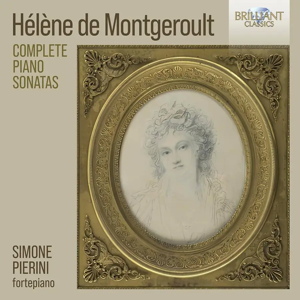
Hélène de Montgeroult (1764-1836)
Piano Sonatas
Simone Pierini (fortepiano)
rec. 2021, Palazzo Annibaldeschi, Monte Compatri, Italy
Brilliant Classics 96247 [3 CDs: 165]
I first got interested in Hélène de Montgeroult when I heard one of two programmes of her work in Composer of the Week on BBC Radio 3, and so was pleased to find these sonatas arriving for review. She had an interesting life. She was French and born a minor aristocrat and, in the years before the revolution, was active as a pianist and harpsichord player. She survived the revolution – there is a story that she won her freedom by improvising on the Marseillaise, but this is probably too good to be true. She was appointed a teacher of piano at the Paris Conservatoire on its foundation in 1795, on the same terms as her male colleagues, but resigned in 1798.
Her output was not large and was all for the piano. Her magnum opus was her Cours complet pour l’enseignement du forte-piano, with 972 exercises and 114 études. Otherwise, her main contribution was her cycle of piano sonatas, of which there are nine, three each in her Opp. 1, 2 and 5 and all included here. As you will see from the listing below, they are not presented in chronological order, but that is how I listened to them.
The sonatas of Op. 1 are each in only two movements, both fast. Her themes are robust and energetic, her writing varied and consistently interesting and her mood is mainly cheerful, though there are some excursions to minor keys, notably in the third sonata. But what particularly impressed me was that the idiom is very close to early Beethoven, to his Op. 1 piano sonatas in fact. I then checked the dates and found that Montgeroult’s Op. 1 was published in 1795, the year before Beethoven’s Op. 1 set. Nor do they disappear in comparison with his.
The Op. 2 set followed in 1800, and you can hear her extending her range. Two of these are minor keys and two have slow movements. That of the C major, the second of the set, is simply an Andantino, but that of the A minor, the third, is a real Adagio. The Andantino, I should add, is really charming, and there are also flashes of wit in the quick movements.
The Op. 5 set was published in 1811 and these are much larger works, two of them in three movements and one in four. They all have substantial first movements, much longer than their successors. The first is a wide-ranging work, with a good deal of variety in the first movement, which at times reminded me both of Mozart and of Weber. There is also a plaintive Adagio, a rather gentle Scherzo – the only such movement in the cycle – and a jolly finale, with some surprising modulations. The other two are both in minor keys, the third indeed in F sharp minor, which I would think a rare key in those days. Both seem to me to show the influence of Beethoven, particularly the Pathétique and Moonlight sonatas, which had been published a few years earlier and become very popular. The second in the set has the most striking opening of all these works, which is perhaps why it was chosen to lead the first disc. There follows a slow movement, marked Aria con espressione and a ferocious finale. The third is in rather similar vein, though the slow movement here is a true Adagio. These are all impressive works, and it a shame that Montgeroult wrote no more sonatas. I must investigate her Cours complet.
Simone Pierini, the pianist here, plays fluently and vigorously. He sometimes adds ornaments and decorations, particularly when passages are marked to be repeated, and he also occasionally slightly desynchronises the hands, to bring out the top line. All this is done in good style. He is a fortepiano specialist, though he also plays the harpsichord, and he wrote a dissertation about the transition from harpsichord to fortepiano. He also wrote the booklet notes here. He plays a Haselmann instrument from the first decade of the nineteenth century, which is the right period for this music. But here, I am afraid, I have my reservation about this recital. I am not a great fan of the fortepiano at the best of times. I allow that they can vary considerably, but I found this one particularly unsatisfactory: shallow and clattery in tone, with little or no resonance and producing an unpleasant jangle in chordal passages. I think Montgeroult was writing rather beyond the capabilities of the instruments of her time, as I believe Beethoven was also, and I would much rather have heard these works on a modern piano. There is, in fact, a rival recording, the only one at present, on the Grand Piano label, in which Nicolas Horvath uses a modern Steinway, and I would probably prefer that. Horvath gets them onto two discs instead of three, and it may be that he plays fewer repeats. Be that as it may, his set costs nearly twice the price of Pierini here. Others may be happier with the fortepiano than I am. But either way Montgerault is worth exploring. So often when a forgotten figure is revived and praised, one suspects special pleading. Not here: I greatly prefer what I have heard of her work to Clementi, Hummel and other second rank worthies of the time.
Stephen Barber
Help us financially by purchasing from



Contents
Sonata in F minor Op. 5 No. 2
Sonata in F Op 1 No. 1
Sonata in E flat Op. 1 No. 2
Sonata in F minor Op. 1 No. 3
Sonata in F sharp minor Op. 5 No. 3
Sonata in D Op. 5 No. 1
Sonata in G minor Op. 2 No. 1
Sonata in C Op. 2 No. 2
Sonata in A minor Op. 2 No. 3

















